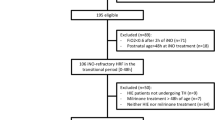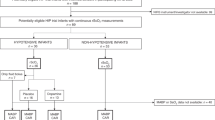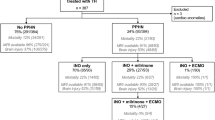Abstract
Aim
to evaluate the correlation of recovery of arterial pressure with physiological recovery among patients with hypoxic ischemic encephalopathy undergoing therapeutic hypothermia.
Methods
At 24 h postnatal age, we compared 53 neonates of whom 22 (41%) were inotrope-treated to those untreated with cardiovascular medications.
Results
Inotrope-treated patients had persistent severe right ventricular (RV) dysfunction and evidence of abnormal brain tissue oxygen delivery, despite recovered arterial pressure.
Conclusion
Arterial pressure is not reflective of RV function and the need for inotropic agents may be reflective of abnormal brain tissue oxygen delivery.
This is a preview of subscription content, access via your institution
Access options
Subscribe to this journal
Receive 12 print issues and online access
$259.00 per year
only $21.58 per issue
Buy this article
- Purchase on Springer Link
- Instant access to full article PDF
Prices may be subject to local taxes which are calculated during checkout

Similar content being viewed by others
Data availability
Data upon which conclusions are based will be made available on reasonable request to the PI.
References
Giesinger RE, Levy PT, Ruoss JL, El Dib M, Mohammad K, Wintermark P, et al. Cardiovascular management following hypoxic-ischemic encephalopathy in North America: need for physiologic consideration. Pediatr Res. 2021;90:600–7.
Groves AM, Kuschel CA, Knight DB, Skinner JR. Relationship between blood pressure and blood flow in newborn preterm infants. Arch Dis Child Fetal Neonatal Ed. 2008;93:F29–32.
Shah P, Riphagen S, Beyene J, Perlman M. Multiorgan dysfunction in infants with post-asphyxial hypoxic-ischaemic encephalopathy. Arch Dis Child Fetal Neonatal Ed. 2004;89:F152–155.
Shah S, Tracy M, Smyth J. Postnatal lactate as an early predictor of short-term outcome after intrapartum asphyxia. J Perinatol. 2004;24:16–20.
Eriksen VR, Trautner S, Hahn GH, Greisen G. Lactate acidosis and cardiac output during initial therapeutic cooling in asphyxiated newborn infants. PLoS ONE. 2019;14:e0213537.
Bozkurt O, Yucesoy E. Acute kidney injury in neonates with perinatal asphyxia receiving therapeutic hypothermia. Am J Perinatol. 2021;38:922–9.
Guluma KZ, Liu L, Hemmen TM, Acharya AB, Rapp KS, Raman R, et al. Therapeutic hypothermia is associated with a decrease in urine output in acute stroke patients. Resuscitation. 2010;81:1642–7.
Kharrat A, Rios DI, Weisz DE, Giesinger RE, Groves A, Yang J, et al. The relationship between blood pressure parameters and left ventricular output in neonates. J Perinatol. 2019;39:619–25.
Pazandak C, McPherson C, Abubakar M, Zanelli S, Fairchild K, Vesoulis Z. Blood pressure profiles in infants with hypoxic ischemic encephalopathy (HIE), response to dopamine, and association with brain Injury. Front Pediatr. 2020;8:512.
Al Balushi A, Barbosa Vargas S, Maluorni J, Sanon PN, Rampakakis E, Saint-Martin C, et al. Hypotension and brain Injury in asphyxiated newborns treated with hypothermia. Am J Perinatol. 2018;35:31–38.
Mohammad K, Hicks M, Buchhalter J, Esser MJ, Irvine L, Thomas S, et al. Hemodynamic instability associated with increased risk of death or brain injury in neonates with hypoxic ischemic encephalopathy. J Neonatal Perinat Med. 2017;10:363–70.
Rios DR, Lapointe A, Schmolzer GM, Mohammad K, VanMeurs KP, Keller RL, et al. Hemodynamic optimization for neonates with neonatal encephalopathy caused by a hypoxic ischemic event: Physiological and therapeutic considerations. Semin Fetal Neonatal Med. 2021;26:101277.
Barberi I, Calabro MP, Cordaro S, Gitto E, Sottile A, Prudente D, et al. Myocardial ischaemia in neonates with perinatal asphyxia. Electrocardiographic, echocardiographic and enzymatic correlations. Eur J Pediatr. 1999;158:742–7.
Costa S, Zecca E, De Rosa G, De Luca D, Barbato G, Pardeo M, et al. Is serum troponin T a useful marker of myocardial damage in newborn infants with perinatal asphyxia? Acta Paediatr. 2007;96:181–4.
Sehgal A, Wong F, Mehta S. Reduced cardiac output and its correlation with coronary blood flow and troponin in asphyxiated infants treated with therapeutic hypothermia. Eur J Pediatr. 2012;171:1511–7.
Giesinger RE, El Shahed AI, Castaldo MP, Breatnach CR, Chau V, Whyte HE, et al. Impaired right ventricular performance Is associated with adverse outcome after hypoxic ischemic encephalopathy. Am J Respir Crit Care Med. 2019;200:1294–305.
More KS, Sakhuja P, Giesinger RE, Ting JY, Keyzers M, Sheth JN, et al. Cardiovascular associations with abnormal brain magnetic resonance imaging in neonates with hypoxic ischemicencephalopathy undergoing therapeutic hypothermia and rewarming. Am J Perinatol. 2018;35:979–89.
Giesinger RE, El Shahed AI, Castaldo MP, Bischoff AR, Chau V, Whyte HEA, et al. Neurodevelopmental outcome following hypoxic ischaemic encephalopathy and therapeutic hypothermia is related to right ventricular performance at 24-hour postnatal age. Arch Dis Child Fetal Neonatal Ed. 2022;107:70–75.
Giesinger RE, McNamara PJ. Hemodynamic instability in the critically ill neonate: an approach to cardiovascular support based on disease pathophysiology. Semin Perinatol. 2016;40:174–88.
Jain A, El-Khuffash AF, Kuipers BC, Mohamed A, Connelly KA, McNamara PJ, et al. Left ventricular function in healthy term neonates during the transitional period. J Pediatr. 2017;182:197–203.e192.
Jain A, Mohamed A, El-Khuffash A, Connelly KA, Dallaire F, Jankov RP, et al. A comprehensive echocardiographic protocol for assessing neonatal right ventricular dimensions and function in the transitional period: normative data and z scores. J Am Soc Echocardiogr. 2014;27:1293–304.
Slama M, Susic D, Varagic J, Ahn J, Frohlich ED. Echocardiographic measurement of cardiac output in rats. Am J Physiol Heart Circ Physiol. 2003;284:H691–697.
Rudolph AM, Heymann MA. The circulation of the fetus in utero. Methods for studying distribution of blood flow, cardiac output and organ blood flow. Circ Res. 1967;21:163–84.
Reller MD, Morton MJ, Reid DL, Thornburg KL. Fetal lamb ventricles respond differently to filling and arterial pressures and to in utero ventilation. Pediatr Res. 1987;22:621–6.
Bamber AR, Pryce J, Cook A, Ashworth M, Sebire NJ. Myocardial necrosis and infarction in newborns and infants. Forensic Sci Med Pathol. 2013;9:521–7.
Altit G, Bonifacio SL, Guimaraes CV, Bhombal S, Sivakumar G, Yan B, et al. Cardiac dysfunction in neonatal HIE is associated with increased mortality and brain Injury by MRI. Am J Perinatol. 2021. https://doi.org/10.1055/s-0041-1735618. Online ahead of print.
Barrington KJ, Finer NN, Chan WK. A blind, randomized comparison of the circulatory effects of dopamine and epinephrine infusions in the newborn piglet during normoxia and hypoxia. Crit Care Med. 1995;23:740–8.
Manouchehri N, Bigam DL, Churchill T, Rayner D, Joynt C, Cheung PY. A comparison of combination dopamine and epinephrine treatment with high-dose dopamine alone in asphyxiated newborn piglets after resuscitation. Pediatr Res. 2013;73:435–42.
Rubini A. Effect of perfusate temperature on pulmonary vascular resistance and compliance by arterial and venous occlusion in the rat. Eur J Appl Physiol. 2005;93:435–9.
Smith A, Purna JR, Castaldo MP, Ibarra-Rios D, Giesinger RE, Rios DR, et al. Accuracy and reliability of qualitative echocardiography assessment of right ventricular size and function in neonates. Echocardiography. 2019;36:1346–52.
Hochwald O, Jabr M, Osiovich H, Miller SP, McNamara PJ, Lavoie PM. Preferential cephalic redistribution of left ventricular cardiac output during therapeutic hypothermia for perinatal hypoxic-ischemic encephalopathy. J Pediatr. 2014;164:999–1004.e1001.
Liu J, Cao HY, Huang XH, Wang Q. The pattern and early diagnostic value of Doppler ultrasound for neonatal hypoxic-ischemic encephalopathy. J Trop Pediatr. 2007;53:351–4.
Wintermark P, Hansen A, Warfield SK, Dukhovny D, Soul JS. Near-infrared spectroscopy versus magnetic resonance imaging to study brain perfusion in newborns with hypoxic-ischemic encephalopathy treated with hypothermia. NeuroImage. 2014;85:287–93.
Nishimaki S, Iwasaki S, Minamisawa S, Seki K, Yokota S. Blood flow velocities in the anterior cerebral artery and basilar artery in asphyxiated infants. J Ultrasound Med. 2008;27:955–60.
Author information
Authors and Affiliations
Contributions
REG collected data, did analysis, wrote the first draft of the manuscript. AFE participated in study design, analysis, review and approval of the final manuscript. PJM participated in study design, analysis, review and approval of the final manuscript
Corresponding author
Ethics declarations
Competing interests
The authors declare no competing interests.
Additional information
Publisher’s note Springer Nature remains neutral with regard to jurisdictional claims in published maps and institutional affiliations.
Rights and permissions
Springer Nature or its licensor (e.g. a society or other partner) holds exclusive rights to this article under a publishing agreement with the author(s) or other rightsholder(s); author self-archiving of the accepted manuscript version of this article is solely governed by the terms of such publishing agreement and applicable law.
About this article
Cite this article
Giesinger, R.E., El-Khuffash, A.F. & McNamara, P.J. Arterial pressure is not reflective of right ventricular function in neonates with hypoxic ischemic encephalopathy treated with therapeutic hypothermia. J Perinatol 43, 162–167 (2023). https://doi.org/10.1038/s41372-022-01567-3
Received:
Revised:
Accepted:
Published:
Issue Date:
DOI: https://doi.org/10.1038/s41372-022-01567-3



